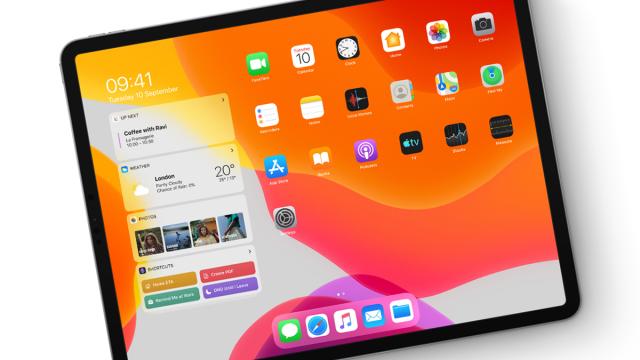The big iPad-exclusive features (like the Dock) first started appearing in iOS 11, and now Apple’s tablets have a whole separate mobile operating system to call their own. To mark the debut of iPadOS, which starts on version 13 for continuity’s sake, here are the best features you can use on an iPad but not an iPhone.
Add widgets to the home screen
iPadOS becomes Android! Sort of. With a swipe to the right on the home screen, you can bring the Today View widgets into view, and keep them there, if you want — just toggle the switch under Home Screen Layout on the Display & Brightness tab of Settings.
You can have iPadOS show smaller or bigger icons on the home screen as well, depending on how you want to use all that iPad screen space: Just choose More or Bigger under Home Screen Layout on the same Settings tab. Widgets can’t be pinned to the home screen in the Bigger mode, but they can still be viewed with a swipe to the right.
Use your iPad as a second display
iPadOS and a new feature called Sidecar allow an iPad to be used as a wired or wireless secondary display (complete with software Touch Bar) for any Mac running macOS Catalina — you can even use the Apple Pencil as a makeshift trackpad or mouse on your iPad when in Sidecar mode. The easiest way to launch Sidecar, once your iPad and Mac are on the same wifi network or connected together, is to open up the AirPlay devices list from the macOS menu.
Navigate from the Dock
The Dock was around before iPadOS, but it remains one of the best iPad-only features — a Mac-style navigation bar for launching apps and accessing the various multitasking options in iPadOS.
Long press on an app icon, then choose Rearrange apps and drag the icon down to the bottom of the screen to pin it to the Dock. The Dock is always visible on the home screens and can be brought up when hidden with a quick swipe up from the bottom of the display.
With iPadOS, you can create folders of app icons as well, just as you would on one of the home screens — drag one app on top of another to create a folder.
Run apps in Split View
The Dock is also the key to Split View: With one app on screen, tap and drag another app icon to the left or the right-hand edge of the display, then use the black bar in between the two apps to decide what sort of screen split you want to have.
Certain apps, including Notes, Mail and Safari, now support multiple windows. Try dragging a note entry, or an email conversation, or a Safari tab over to the side of the screen, and you’ll see Split View is enabled — very handy if, for example, you’re trying to take notes from two webpages at once.
Run apps in Slide Over
Slide Over gets some extra multitasking abilities in iPadOS. You can drag an app up from the Dock to the right or left (but not quite the edge of the screen) to put it into Slide Over mode, as before. Yet now a swipe up on the Slide Over sidebar brings up all the apps you’ve recently used in this mode. To switch quickly between the two most recently used Slide Over apps, swipe across the bar at the bottom.
Make use of drag and drop
When you’ve got all your apps up in multiple windows, side by side — squint your eyes and it’s almost like you’re using a laptop — you can drag and drop pictures and links from one app to another. Tap and hold on something you want to transfer, then move it over to the app on the other side of the screen.
Move the keyboard
With iPadOS, you can pick up and drag the keyboard, then position it wherever you want on screen. Use a two-finger pinch to make the keyboard portable, then a two-finger drag-and-drop (or the bar at the bottom) to move it around, then a two-finger expand gesture to put the keyboard back where it was again.
Browse files in column view
The Files app on iPadOS supports more views than the Files app on iPhone: When you’re inside a folder, drag down from the top right-hand corner of that folder (not the screen as a whole) to reveal more display options. You can pick from grid, list, and column views, with that last one making it much easier to dive deep into several subfolders on your iPad.
The column view also activates a window on the far right of the interface that previews certain file types, including images and some documents. When one of these files is selected, iPadOS lets you access certain quick actions too — rotating or annotating images, for example.
Browse websites in desktop mode
One of the biggest differences between using a laptop and using an iPad is that you don’t get the full desktop web experience with Apple tablets. Apple is trying to do something about that by adding a desktop mode to Safari on iPadOS.
While it’s not perfect — Apple is applying some under-the-hood tricks to get desktop sites looking better in iPadOS Safari, and the lack of a pointing device is keenly felt on some sites — it works well for sites like Google Docs and WordPress.
Use the Apple Pencil
You can use the Apple Pencil as a super-accurate, super-sensitive stylus on the iPad; you cannot, as yet, use it with the iPhone.
